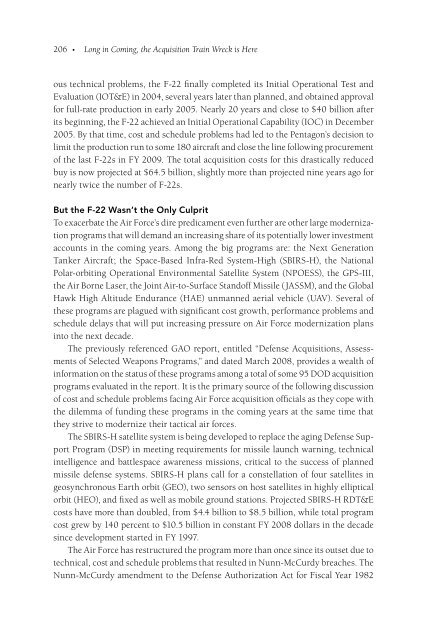Americas Defense Meltdown - IT Acquisition Advisory Council
Americas Defense Meltdown - IT Acquisition Advisory Council
Americas Defense Meltdown - IT Acquisition Advisory Council
You also want an ePaper? Increase the reach of your titles
YUMPU automatically turns print PDFs into web optimized ePapers that Google loves.
206 • Long in Coming, the <strong>Acquisition</strong> Train Wreck is Hereous technical problems, the F-22 finally completed its Initial Operational Test andEvaluation (IOT&E) in 2004, several years later than planned, and obtained approvalfor full-rate production in early 2005. Nearly 20 years and close to $40 billion afterits beginning, the F-22 achieved an Initial Operational Capability (IOC) in December2005. By that time, cost and schedule problems had led to the Pentagon’s decision tolimit the production run to some 180 aircraft and close the line following procurementof the last F-22s in FY 2009. The total acquisition costs for this drastically reducedbuy is now projected at $64.5 billion, slightly more than projected nine years ago fornearly twice the number of F-22s.But the F-22 Wasn’t the Only CulpritTo exacerbate the Air Force’s dire predicament even further are other large modernizationprograms that will demand an increasing share of its potentially lower investmentaccounts in the coming years. Among the big programs are: the Next GenerationTanker Aircraft; the Space-Based Infra-Red System-High (SBIRS-H), the NationalPolar-orbiting Operational Environmental Satellite System (NPOESS), the GPS-III,the Air Borne Laser, the Joint Air-to-Surface Standoff Missile (JASSM), and the GlobalHawk High Altitude Endurance (HAE) unmanned aerial vehicle (UAV). Several ofthese programs are plagued with significant cost growth, performance problems andschedule delays that will put increasing pressure on Air Force modernization plansinto the next decade.The previously referenced GAO report, entitled “<strong>Defense</strong> <strong>Acquisition</strong>s, Assessmentsof Selected Weapons Programs,” and dated March 2008, provides a wealth ofinformation on the status of these programs among a total of some 95 DOD acquisitionprograms evaluated in the report. It is the primary source of the following discussionof cost and schedule problems facing Air Force acquisition officials as they cope withthe dilemma of funding these programs in the coming years at the same time thatthey strive to modernize their tactical air forces.The SBIRS-H satellite system is being developed to replace the aging <strong>Defense</strong> SupportProgram (DSP) in meeting requirements for missile launch warning, technicalintelligence and battlespace awareness missions, critical to the success of plannedmissile defense systems. SBIRS-H plans call for a constellation of four satellites ingeosynchronous Earth orbit (GEO), two sensors on host satellites in highly ellipticalorbit (HEO), and fixed as well as mobile ground stations. Projected SBIRS-H RDT&Ecosts have more than doubled, from $4.4 billion to $8.5 billion, while total programcost grew by 140 percent to $10.5 billion in constant FY 2008 dollars in the decadesince development started in FY 1997.The Air Force has restructured the program more than once since its outset due totechnical, cost and schedule problems that resulted in Nunn-McCurdy breaches. TheNunn-McCurdy amendment to the <strong>Defense</strong> Authorization Act for Fiscal Year 1982


